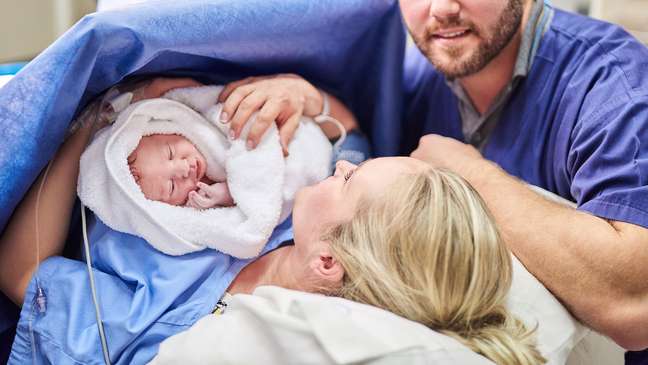Anesthesia from the waist down, a partner, professionals close to the pregnant woman’s head … Understanding what is normal or not in this type of procedure
A necessary caesarean section can save lives – for the mother, for the baby, or for both, as the case may be. In Brazil, according to data from the National Supplementary Health Agency (ANS), 84% of births are surgical, although the rate recommended by the World Health Organization (WHO) ranges from 10 to 15% – this is because the procedure, although known, involves greater risks than vaginal birth and requires a correct indication.

In addition to the medical risks common to any surgery, women have another fear added to the list, that of abuse. Recently, in Rio de Janeiro, nurses managed to film a anesthetist raping a sedated patient during a caesarean sectionwhile giving birth to her baby.
With all the indignation of the case, several doubts have arisen in relation to the caesarean section. What is common? What is it not? Does the woman really need to be sedated, as the patient said? Should the anesthetist be close to the patient’s face? Are there situations in which the mother cannot have a partner present?
To better understand all these problems, we spoke with the gynecologist and obstetrician Wagner Hernandez, from São Paulo (SP), who explained very important points to us.
1. In a caesarean section, how many people are in the operating room?
In general, there are an obstetrician, an auxiliary obstetrician, there may be a nurse (another doctor or nurse), a pediatrician, an anesthetist, a nurse and a nursing assistant. This is considering a minimal team, in a common caesarean. It is possible to have variations, in the private service, for those who hire a photographer and doula. Furthermore, the patient is entitled to an accompanying person.
2. Are there any cases in which you cannot have a partner?
The parturient has the right to an accompanying person, regardless of the type of birth and theoretically there should be no restrictions whatsoever. Some places try to prohibit the presence of a partner in the postpartum period, for example, due to the fact that other women in the recovery room may feel embarrassed. However, this shouldn’t be a deterrent. The ideal would be to modify the structure of the environment, installing screens or curtains to guarantee the presence of the companion 100% of the time, since this is a standard guaranteed by federal law n. 11.108.
3. Is the tissue barrier that separates the mother’s body always used?
Yes. They are the so-called sterile surgical drapes. They are used to prevent infections. Popularly, they are known as “tent”. At the bottom, that is, near the mother’s womb, there are the two midwives and the dog. Only those who are dressed for the procedure are allowed in this region. At the top are the anesthetist and possibly the nursing technician and a pediatrician. The latter will help if the child is restrained. In fact, in short, anyone can stay in this area.
4. Where can the companion stay? Do you see everything?
The carer can access both the upper part of the mother (and talk to her), or attend the surgery, attend the birth of the child. Despite this, doctors usually pay special attention in the latter case, because, due to the blood resulting from the procedure, some people can feel sick.

5. Is the anesthetist always present? Does he need to be close to the patient’s face?
Yup, the anesthetist must be present throughout the operation, precisely to assist the woman in childbirth. In the event of an interchange, such as a drop or increase in blood pressure or bleeding during the procedure, he is the one who offers assistance. However, most of the time, it is not necessary to be close to the woman’s face, unless there is a respiratory problem or she needs to be intubated using an oxygen catheter, for example.
6. Is it normal for a pregnant woman to be sedated for a caesarean section?
There is hardly any indication for sedating a woman after giving birth.. Only in cases of extreme agitation or something. The idea is, in fact, for the mother to stay awake to see the baby, to come into skin-to-skin contact and breastfeed while the doctors finish the caesarean section.
7. Is it normal for anesthesia to occur only from the waist down?
THE the main anesthesia for caesarean section is spinal anesthesia [da cintura para baixo], but it is not the only one. If the woman is in labor, for example, and she has a caesarean section, she won’t always need to take a new anesthetic if she already has labor analgesia. In some, much rarer cases, general anesthesia is required, which is when the woman actually sleeps from start to finish.but these are exceptional situations.
8. Is the mother staying with a partner during recovery?
He usually spends about two hours in postpartum recovery, until the leg movement returns. In this period, the ideal is to be with a partner. The baby, too, should not be separated from her if possible, unless she has to go to intensive care or the mother is very sleepy or, for some specific reason, cannot be with her.
9. How long does the effect of anesthesia last after caesarean section?
The effect of spinal anesthesia is two to three hours maximum. The same goes for the epidural. In the case of general anesthesia, at the end of the procedure, the anesthetic ceases to be widespread, the woman wakes up and begins to regain consciousness. Recalling that the need for general anesthesia in caesarean section is an exception to the exception.
Source: Terra
Benjamin Smith is a fashion journalist and author at Gossipify, known for his coverage of the latest fashion trends and industry insights. He writes about clothing, shoes, accessories, and runway shows, providing in-depth analysis and unique perspectives. He’s respected for his ability to spot emerging designers and trends, and for providing practical fashion advice to readers.







